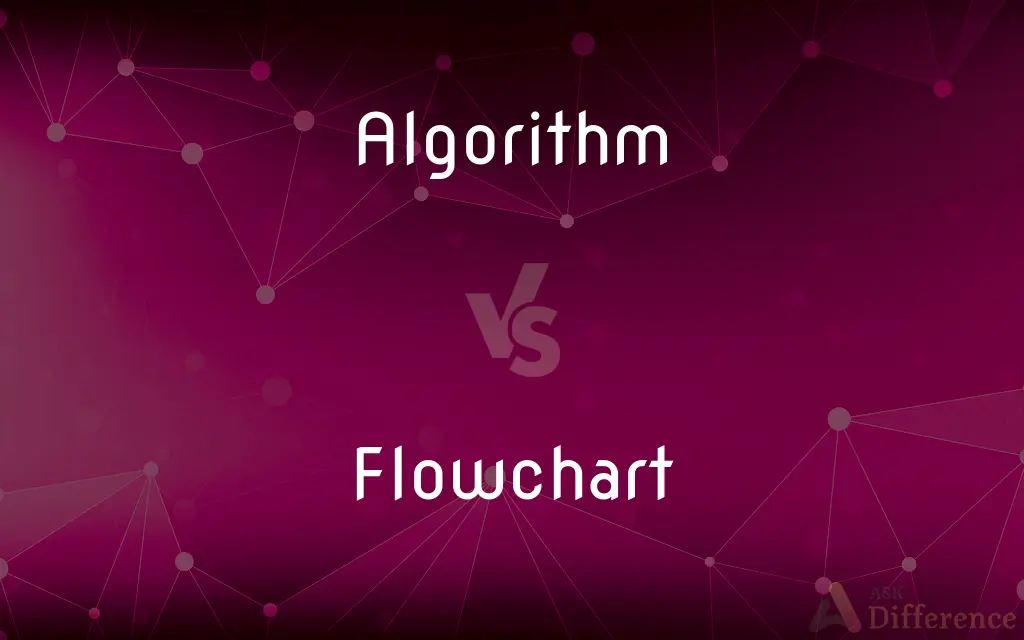Algorithm vs. Flowchart — What's the Difference?
By Tayyaba Rehman — Updated on September 20, 2023
An algorithm is a set of step-by-step instructions for solving a problem, while a flowchart visually represents the sequence of steps in a process. Both offer ways to understand processes and solutions.

Difference Between Algorithm and Flowchart
Table of Contents
ADVERTISEMENT
Key Differences
An Algorithm is fundamentally a sequence of steps or a set of rules to solve a particular problem. It's like a recipe in a cookbook, detailing the "what" and "how" of reaching a solution. Algorithms can be expressed in various forms, including natural language, pseudocode, or programming languages.
On the other hand, a Flowchart is a visual tool that graphically represents these steps or a process. Utilizing various shapes and arrows, a flowchart provides a pictorial representation of an algorithm or process, making it easier to understand at a glance.
While an Algorithm focuses on the essence of the solution, a Flowchart concentrates on the flow of the process. The algorithm offers the logical sequence, and when you need to visualize it, especially for complex processes, you might turn it into a flowchart.
In summary, an Algorithm is about the content—the precise steps or instructions—while the Flowchart is about the presentation. When working on a problem, you might first develop an algorithm and then, for clarity or communication, represent that algorithm as a flowchart.
Comparison Chart
Nature
Set of instructions
Visual representation of a process
ADVERTISEMENT
Primary Use
Detailing steps to solve a problem
Visualizing steps or processes
Expression
Can be in natural language, pseudocode, etc.
Uses symbols and arrows
Flexibility
Specific to problem-solving
Can represent any process
Interdependence
Can exist without a flowchart
Typically represents an algorithm or process
Compare with Definitions
Algorithm
A step-by-step procedure for calculations.
The computer used an algorithm to sort the data.
Flowchart
A diagram that represents a process, using shapes and symbols.
She created a flowchart to explain the project timeline.
Algorithm
A methodical approach to answer a question.
The machine learning model relies on a complex algorithm.
Flowchart
A schematic representation of an algorithm or process.
The programming logic was easier to understand with a flowchart.
Algorithm
A process or set of rules followed in problem-solving.
The encryption algorithm keeps our data secure.
Flowchart
A chart filled with boxes and arrows that illustrate a workflow.
Their team made a flowchart to enhance the manufacturing process.
Algorithm
A specific sequence to achieve a desired output.
He designed an efficient search algorithm.
Flowchart
A graphical depiction of a decision-making process.
Use the flowchart to determine which product to buy.
Algorithm
An operational procedure for solving a mathematical problem.
The math problem can be solved using the Euclidean algorithm.
Flowchart
A visual representation of the sequence of steps in a task.
This flowchart outlines the software's functions.
Algorithm
In mathematics and computer science, an algorithm ( (listen)) is a finite sequence of well-defined, computer-implementable instructions, typically to solve a class of specific problems or to perform a computation. Algorithms are always unambiguous and are used as specifications for performing calculations, data processing, automated reasoning, and other tasks.
Flowchart
A flowchart is a type of diagram that represents a workflow or process. A flowchart can also be defined as a diagrammatic representation of an algorithm, a step-by-step approach to solving a task.
Algorithm
A finite set of unambiguous instructions that, given some set of initial conditions, can be performed in a prescribed sequence to achieve a certain goal and that has a recognizable set of end conditions.
Flowchart
A schematic representation of a sequence of operations, as in a manufacturing process or computer program. Also called flow diagram, flow sheet.
Algorithm
(countable) A collection of ordered steps that solve a mathematical problem. A precise step-by-step plan for a computational procedure that possibly begins with an input value and yields an output value in a finite number of steps.
Flowchart
Alternative spelling of flow chart
Algorithm
Calculation with Arabic numerals; algorism.
Flowchart
A diagram of the sequence of operations in a computer program or an accounting system
Algorithm
A precise rule (or set of rules) specifying how to solve some problem; a set of procedures guaranteed to find the solution to a problem.
Algorithm
A precise rule (or set of rules) specifying how to solve some problem
Common Curiosities
Can an algorithm be represented without a flowchart?
Yes, an algorithm can be expressed in various forms without necessarily using a flowchart.
Which is more detailed, an algorithm or a flowchart?
An algorithm typically provides a more detailed step-by-step process, while a flowchart offers a visual overview.
Can you write code directly from a flowchart?
Yes, a flowchart visually depicts the logic and sequence, making it easier to translate into code, representing the underlying algorithm.
Is every flowchart an algorithm?
Not necessarily. While a flowchart can represent an algorithm, it can also represent any process or sequence of events.
Are flowcharts always linear?
No, flowcharts can have branches, loops, or parallel processes, depending on the algorithm or process they represent.
Are algorithms always used in computing?
No, while algorithms are common in computing, they're essentially problem-solving sequences and can be applied in various disciplines.
How are algorithms tested?
Algorithms are tested using specific inputs to ensure they produce the expected outputs and handle various scenarios.
Can multiple algorithms have the same flowchart representation?
Rarely, as each algorithm has unique steps. However, different algorithms might solve the same problem and thus have similar flowcharts.
Is a flowchart always drawn before creating an algorithm?
Not always. Sometimes, the algorithm is devised first, and a flowchart is created later for visualization or communication.
Is every step in a flowchart mandatory?
No, a flowchart can have optional paths or decision points based on conditions.
Why use flowcharts in the first place?
Flowcharts provide a visual summary, aiding comprehension and communication of a process or algorithm.
Can two people create different algorithms for the same problem?
Absolutely. There are often multiple algorithms to solve a given problem, each with its advantages and trade-offs.
Can algorithms be patented?
In the U.S., certain algorithms can be patented if they meet specific criteria, though it's a complex area of law.
Which is easier to modify, an algorithm or a flowchart?
It depends on the complexity. However, visually, a flowchart might be quicker to adjust for minor changes.
Can flowcharts be digital or interactive?
Yes, there are software tools that allow creation of interactive digital flowcharts.
Share Your Discovery

Previous Comparison
Triceratops vs. Tyrannosaurus
Next Comparison
Holly vs. MistletoeAuthor Spotlight
Written by
Tayyaba RehmanTayyaba Rehman is a distinguished writer, currently serving as a primary contributor to askdifference.com. As a researcher in semantics and etymology, Tayyaba's passion for the complexity of languages and their distinctions has found a perfect home on the platform. Tayyaba delves into the intricacies of language, distinguishing between commonly confused words and phrases, thereby providing clarity for readers worldwide.














































